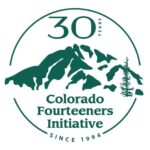Recommended Route Halfmoon Creek Route (also called the North Mount Elbert Trail) or the Mount Elbert Trail (also called the South Mount Elbert Trail) – use of these routes will help to reduce impacts to this Fourteener’s fragile alpine environment. For more detailed route information including pictures, maps, and elevation profiles, click here for Halfmoon/North Mount Elbert or click here for the South Mount Elbert trail.
Route Information and Additional Resources Halfmoon Creek Route: The trailhead is approximately eleven miles west of Leadville. It is past Halfmoon West Campground, and is just west of Elbert Creek Campground. The trailhead is Mount Massive-Mount Elbert Trailhead. The route heads south from the trailhead down the well-marked Main Range/Colorado Trail. The North Mount Elbert trail forks right off the Main Range/Colorado Trail. Follow the trail all the way to the summit. There is very little water along this route; all water should be packed in. Stay on the trail. Older maps and guidebooks will show this route incorrectly. The Trails Illustrated® map #127 is the most current, as the trail was reconstructed in 1993.
Mount Elbert Trail Route: From the junction of US 24 and Colorado 82 near Twin Lakes. Travel approximately four miles to Lake County 24, then north one mile to Lake View campground. The Colorado Trail passes through the campground. Follow the Colorado Trail north to the junction with Mount Elbert Trail. Follow the Mount Elbert Trail northwest and west to the summit. Some maps refer to this trail as the South Mount Elbert Trail. The South Mount Elbert trail is very steep and in need of repair. Many trail junctions near the South Mount Elbert Trail/Colorado Trail junction can be confusing, especially on the return trip. Stay alert on the way up to avoid difficulties and wrong turns on the way down.
The above information does not replace the need to consult additional maps and Colorado Fourteener Guidebooks for more detailed route descriptions. We suggest checking multiple resources before departing on any hike. Keep in mind that not all guidebooks list this recommended route and that each guidebook’s description or route name may vary slightly.
Peak Specific Environmental and Safety Concerns In Spring snowfields cover the trail. Travel across snowfields until the trail can be regained. Do not travel on fragile alpine vegetation. Don’t cut switchbacks. Respect Wildlife. Elk calving areas exist near this trail. Please keep your distance to avoid undue stress to the animals.


